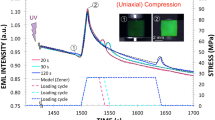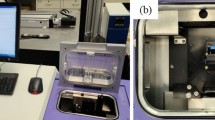Abstract
THE dielectric properties of inorganic glasses in alternating fields are usually described in terms of the complex dielectric constant  where ε′ is the real part and ε″ is the imaginary part or dielectric loss. The values of ε′ and ε″ are usually obtained from measurements of the capacitance and resistance of a disk shaped specimen fitted with metal electrodes. If the value of Cp/Co (where Cp is the equivalent parallel capacitance and Co is the capacitance with a vacuum between the electrodes) is plotted against log ω (where ω is the angular frequency), then, in the audiofrequency range and with blocking electrodes (for example, gold or platinum), a curve of the form shown in Fig. 1 is usually obtained with glasses containing appreciable amounts of alkali-metal ions.
where ε′ is the real part and ε″ is the imaginary part or dielectric loss. The values of ε′ and ε″ are usually obtained from measurements of the capacitance and resistance of a disk shaped specimen fitted with metal electrodes. If the value of Cp/Co (where Cp is the equivalent parallel capacitance and Co is the capacitance with a vacuum between the electrodes) is plotted against log ω (where ω is the angular frequency), then, in the audiofrequency range and with blocking electrodes (for example, gold or platinum), a curve of the form shown in Fig. 1 is usually obtained with glasses containing appreciable amounts of alkali-metal ions.
This is a preview of subscription content, access via your institution
Access options
Subscribe to this journal
Receive 51 print issues and online access
$199.00 per year
only $3.90 per issue
Buy this article
- Purchase on Springer Link
- Instant access to full article PDF
Prices may be subject to local taxes which are calculated during checkout
Similar content being viewed by others
References
Isard, J. O., J. Sci. Instrum., 40, 403 (1963).
Volger, J., Stevels, J. M., and van Amerongen, C., Philips res. Reports, 8, 452 (1953).
Stevels, J. M., The Electrical Properties of Glass, Handbuch der Physik, 20, p. 350 (Springer-Verlag, Berlin, 1957).
McCrum, N. G., Read, B. E., and Williams, G., Anelastic and Dielectric Effects in Polymeric Solids, p. 211 (John Wiley and Sons, 1967).
Taylor, H. E., J. Soc. Glass Technol., 41, 350T (1957).
Taylor, H. E., J. Soc. Glass Technol., 43, 124T (1959).
Charles, R. J., J. Appl. Phys., 32, 1115 (1961).
Fröhlich, H., Theory of Dielectrics (Oxford University Press, 1949).
Barton, J. L., Verres et Refr., 20, 328 (1966).
Maxwell, J. C., Electricity and Magnetism., third ed., 1, 450 (Clarendon Press, Oxford, 1892).
Hansen, K. W., and Splann, Mary T., J. Electrochem. Soc., 113, 895 (1966).
Owen, A. E., and Douglas, R. W., J. Soc. Glass Technol., 43, 159T (1959).
Owen, A. E., Progress in Ceramic Science (edit. by J. E. Burke), 3, p. 77 (Pergamon Press, 1963).
Owen, A. E., thesis, Univ. Sheffield (1959).
Miller, R. A., and Hansen, K. W., J. Electrochem. Soc., 116, 254 (1969).
Author information
Authors and Affiliations
Rights and permissions
About this article
Cite this article
HALE, D. Dielectric and Anelastic Effects in Inorganic Glasses. Nature 225, 930–932 (1970). https://doi.org/10.1038/225930a0
Received:
Issue Date:
DOI: https://doi.org/10.1038/225930a0
Comments
By submitting a comment you agree to abide by our Terms and Community Guidelines. If you find something abusive or that does not comply with our terms or guidelines please flag it as inappropriate.



